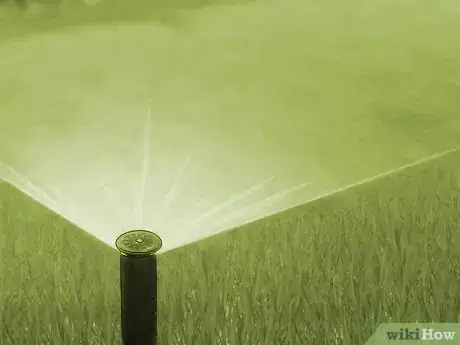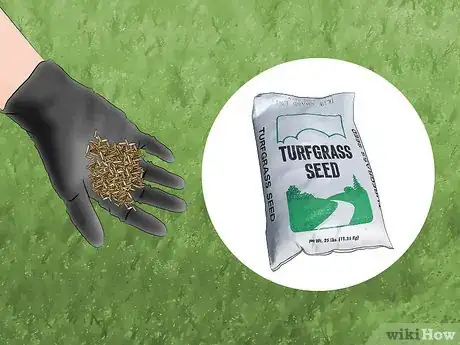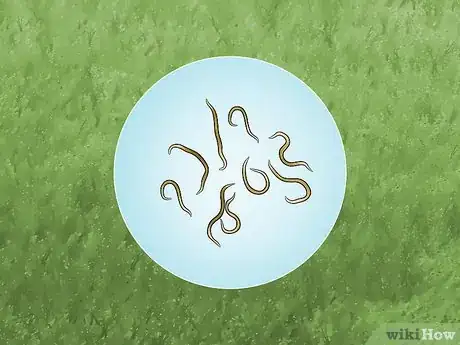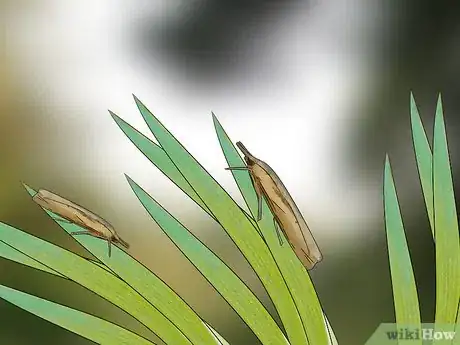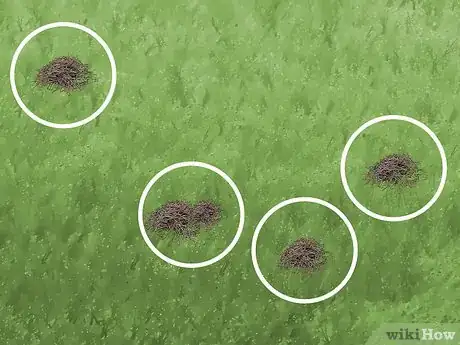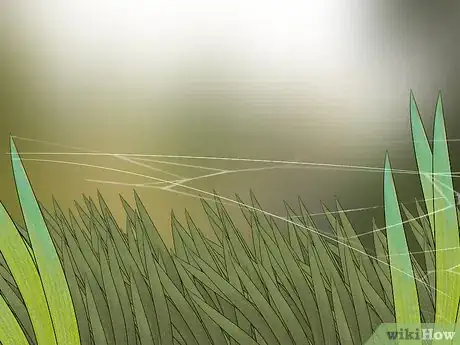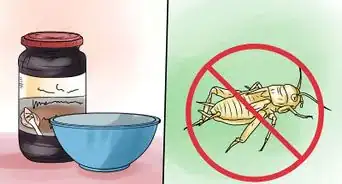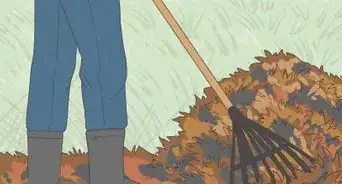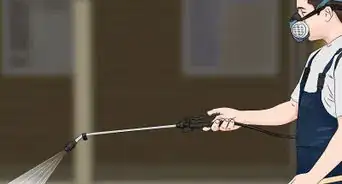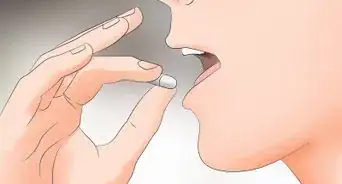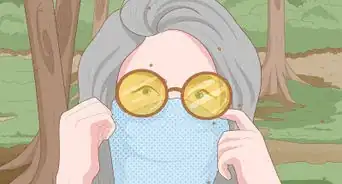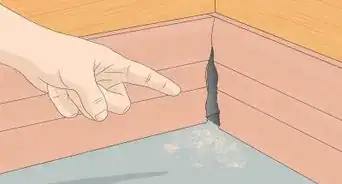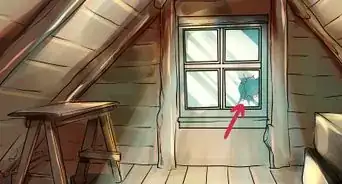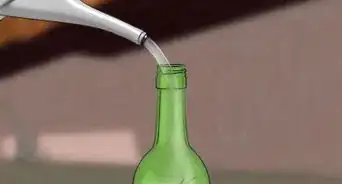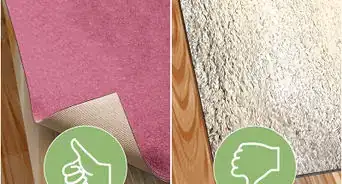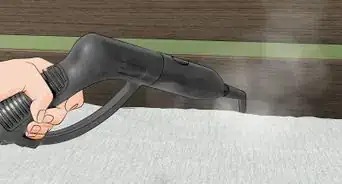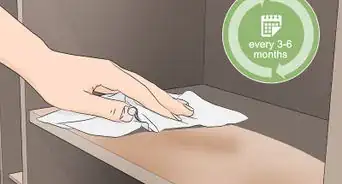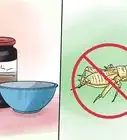This article was co-authored by wikiHow staff writer, Amy Bobinger. Amy Bobinger has been a writer and editor at wikiHow since 2017. She especially enjoys writing articles that help people overcome interpersonal hurdles but frequently covers a variety of subjects, including health and wellness, spirituality, gardening, and more. Amy graduated with a B.A. in English Lit from Mississippi College in 2011 and now lives in her hometown with her husband and two young sons.
This article has been viewed 58,155 times.
Learn more...
If you spend a lot of time making your lawn look nice, it can be frustrating when pests damage your grass. Sod webworms are a type of moth that live in turfgrass. Although the adult moths won’t damage your lawn, the larvae can be extremely destructive, leaving large bare patches of grass. Luckily, it’s easy to get rid of sod webworms yourself.
Steps
Getting Rid of Sod Webworms
-
1Water your lawn regularly. Sod webworm caterpillars build their webs in the layer of dry thatch that forms between grass and the earth. Most light to moderate infestations of sod webworms can be managed by irrigation of the turf.[1]
- How often you water your grass will depend on the climate where you live. However, if the weather is hot and dry, you may need to water your lawn for as much as an hour a day.
-
2Spread endophyte-enhanced turfgrass seed on your lawn. Endophytes are a special kind of fungi that live in grass. They are usually not harmful, but they can repel insects such as sod webworms. Just sprinkle the seeds into your existing grass and water the area until the grass takes root.[2]
- You can buy this special grass seed at most garden supply stores.
- Follow all label instructions, especially if you have livestock which will be eating the grass. Excessive consumption of endophytes can be harmful to certain animals.
Advertisement -
3Spread the nematodes Steinernema spp. to consume sod webworm. Nematodes are an organic solution to getting rid of sod webworm caterpillars. These tiny organisms use the caterpillars as a host, leading to their death. All you have to do is sprinkle them into the grass near the affected areas.[3]
- You can purchase beneficial nematodes from specialty garden centers. However, be sure to check the expiration date, as nematodes have a very short shelf life.
-
4Apply an insecticide in the early evening to treat a severe infestation. If you are noticing extensive grass damage, you may need to use an insecticide. Effective insecticides include those containing acephate, bendiocarb, or carbaryl.[4]
- Watering the grass before you apply an insecticide will help the chemicals penetrate the grass better. It will also force the caterpillars to the surface of the grass.[5]
- You can use either a spray or a granular insecticide. If you use a spray solution, apply at least 15–25 gallons (57–95 L) of insecticide for every 1,000 square feet (93 m2) of grass.
- If you use a granular insecticide, apply it with a fertilizer spreader. Follow the label’s irrigation instructions: usually granular insecticides are followed by about an hour of watering to ensure the granules get down into the turf.[6]
Identifying Sod Webworms
-
1Watch for pale-brown moths on your lawn at dusk. Adult sod webworms are most active on warm evenings, especially during July and August. They are easily identified by their prominent snout and the jerky movements they make as they fly.[7]
- Seeing a few adult sod webworms doesn’t necessarily mean you need to treat your lawn. However, if you see a large number of them, you can assume they will produce a large number of larvae. It's the sod webworm larvae, or caterpillars, that cause damage to your grass.
-
2Look for brown, cut patches in your grass. As the larvae feed on your grass, you will begin to see small patches appear. It will appear that the grass has been cut or sheared.
- Damage from sod webworm caterpillars can be up to the size of a baseball on your lawn. If an infestation is particularly bad, however, these patches may join together, creating even larger brown patches.[8]
- The brown patches may sometimes have visible pencil-sized holes due to birds searching for the webworm larvae.
- Since sod webworm larvae live in the dry thatch beneath grass, damage appears most frequently on slopes and banks that are hard to irrigate.
-
3Examine your turf for webs and fecal pellets. Sod webworm larvae create silky tunnels, or webs, to protect themselves. In addition, they leave frass, or soft green fecal pellets, on grass stems. These will both be visible when you examine the grass.[9]
-
4Flush out the larvae with soapy water. Dilute 2 tablespoons (30 mL) of dish detergent in 1 gallon (3.8 L) of water. Spread the mixture over a 2 ft × 2 ft (0.61 m × 0.61 m) area near the outside of the dead patches of grass.[10]
- The soap will irritate the caterpillars, forcing them to the surface of the grass. This will allow you to see the extent of the infestation.
- If you have 10-15 larvae present, you should treat the area with an insecticide.
- If there are only a few larvae, you can use a rake to destroy them.[11]
Community Q&A
-
QuestionDo I need a pesticide licence to purchase insecticide products?
 Community AnswerYou do not need one for consumer level insecticides sold at garden stores, supermarkets and box stores. However, depending on where you are, you might need a licence for industrial quantities or types of pesticides. Whatever type you get, you should have knowledge of safe handling and use of the insecticides.
Community AnswerYou do not need one for consumer level insecticides sold at garden stores, supermarkets and box stores. However, depending on where you are, you might need a licence for industrial quantities or types of pesticides. Whatever type you get, you should have knowledge of safe handling and use of the insecticides. -
QuestionI been trying to rid of the sod web worm for two years with granulated insecticide and BT but the moths still coming, I’m so worried because I find webs In my plants beds and many of my plants.
 Tina AliCommunity AnswerThe best way is to water your lawn regularly. You really need to spread endophyte-enhanced turfgrass seed on your lawn and apple cider vinegar also. Mix in water before watering.
Tina AliCommunity AnswerThe best way is to water your lawn regularly. You really need to spread endophyte-enhanced turfgrass seed on your lawn and apple cider vinegar also. Mix in water before watering. -
QuestionWhere do sod webworms come from?
 CageyCatTop AnswererSod webworms were first recognized during the drought of 1928–1934. Lawns and golf courses were damaged. This species of moth is native to the United States as pest; it was not introduced here.
CageyCatTop AnswererSod webworms were first recognized during the drought of 1928–1934. Lawns and golf courses were damaged. This species of moth is native to the United States as pest; it was not introduced here.
Warnings
- Be sure to wear rubber gloves, long pants, and rubber boots when you apply an insecticide.⧼thumbs_response⧽
- Keep children and pets away from an area where insecticide has been applied.⧼thumbs_response⧽
References
- ↑ https://entomology.unl.edu/turfent/documnts/swebwrms.shtml
- ↑ http://ento.psu.edu/extension/factsheets/sod-webworms-lawns
- ↑ http://ento.psu.edu/extension/factsheets/sod-webworms-lawns
- ↑ http://harris.agrilife.org/files/2011/05/sodwebworm.pdf
- ↑ https://entomology.unl.edu/turfent/documnts/swebwrms.shtml
- ↑ http://harris.agrilife.org/files/2011/05/sodwebworm.pdf
- ↑ http://ento.psu.edu/extension/factsheets/sod-webworms-lawns
- ↑ http://msue.anr.msu.edu/resources/sod_webworm_tips_for_your_lawn
- ↑ http://ento.psu.edu/extension/factsheets/sod-webworms-lawns
About This Article
If sod webworms are eating your grass, water your lawn thoroughly to help prevent the formation of dry thatch, where the larvae form their webs. If that doesn’t work, try spreading a turfgrass seed enhanced with endophytes to repel the sod webworms. For more severe infestations, apply an insecticide made with acephate, bendiocarb, or carbaryl. Always wear gloves, long pants, and boots when working with insecticides so you aren’t exposed to the chemicals. If you want to learn how to identify sod webworm nests, keep reading the article!
